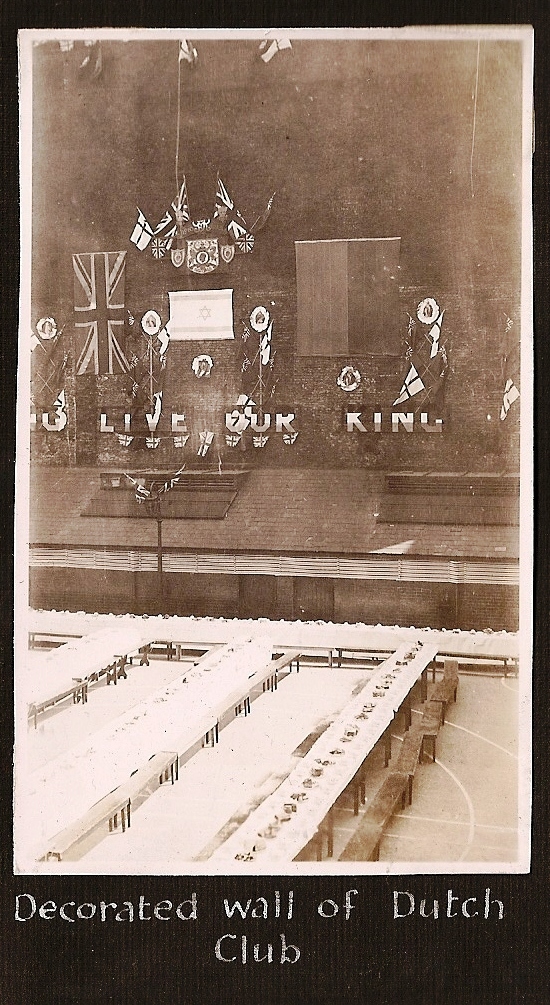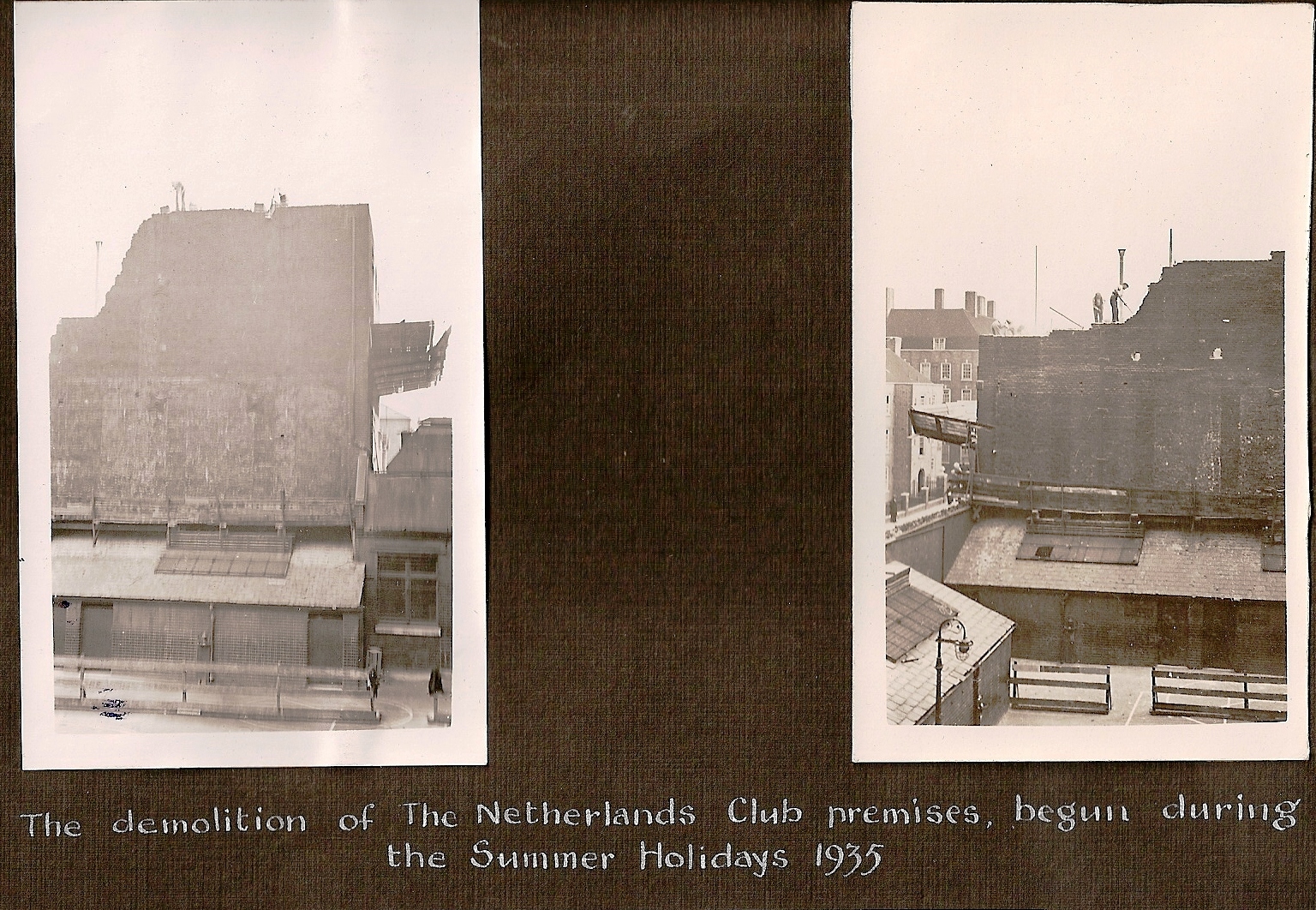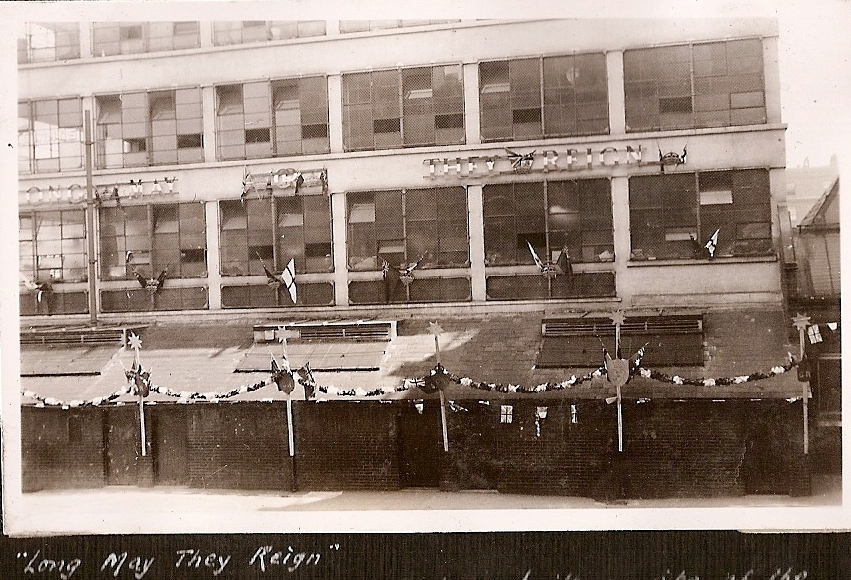|
[Home] [Events] [Gallery] [Publications] [Sidney St exhibition] [Join Jeecs] [Readers help] [Who's who] [Rosenberg]
Welcome to the
Jewish East
End Celebration
Society
Olives,
coocumbers and sammon sangwiches
HAROLD POLLINS
researches the story of the Netherlands Choral and
Dramatic Club, one of the many now forgotten Jewish
clubs that flourished in the East End1
In 1951 the veteran
journalist, Gabriel Costa – he had been writing for
the newspapers before the First World War and
continued to do so until the 1970s – published an
article entitled ‘The Dutch Club: a Vignette.’2
He described certain aspects of the vanished
Netherlands Choral and Dramatic Club. “At no time in
its variegated story,” he wrote, “had the Dutch Club
cherished ‘high-brow’ ambitions. Its mission was
frankly the entertainment of the jaded workers of
the Ghetto at a minimum of expense and with a
minimum of ‘trimmings’.”
It was a social club and,
in particular, he described the often raucous
reception of new plays put on at the club. The
actors would, inter alia, be interrupted by the
waiters’ loud inquiries of the audience: “Any
olives, coocumbers, sammon sangwiches?” Occasionally
the actors would be pelted with pennies but “olive
stones worked out cheaper”.
It is worth stating at
this point that doing research on this and other
Jewish clubs is difficult. Their records do not
appear to have survived and I have had to make use
of items in the Jewish and other newspapers as well
as the published reports of the Club and Institute
Union, to which some of the Jewish clubs belonged.
From them one can piece together at least the
outlines of the various clubs' activities.
Unfortunately there seem to be no lists of members,
but this is not surprising since members paid
monthly or weekly subscriptions and, with several
hundred people with fluctuating membership, it is
unlikely that accurate records would have been kept.
Costa was describing the
club’s later years.The Netherlands Club had begun
quite differently from the description he gave in
1951, coming into existence as the Netherlands
Choral Society on August 15,1869, at a meeting at
the Zetland Hall, 51 Mansell Street, a well-known
East End venue for meetings of all kinds.
The Choral Society had
been formed “For training choristers, and for giving
Entertainments in Aid of Charitable Institutions”.3
As befitted the Dutch origin of the members
(at first the language spoken was Dutch) it had a
title “Nut zy ons doel” (which may be translated as
“Good Intent” or “Usefulness is our Goal”).Another
title was “Ons Genoegen” (“Our Pleasure” or “Our
Content”.)
It
was indeed a choral society. Its conductor was the
renowned Julius Lazarus Mombach (1813-1880), for
many years choirmaster at the Great Synagogue and a
composer. Early in society’s life, the
Jewish Chronicle
reported that“at the funeral of one of its members,
the association, headed by the choir, marched to the
cemetery, singing very finely”.4 And a
few months later, onJuly 8, 1871, the
Jewish Chronicle
reported that “members of the Netherlands Choral
Society serenaded
Mr J. L. Mombach,
their conductor, at his residence, Finsbury Square,
in honour of the success which attended their first
public concert on Wednesday, 5th inst., at the New
Town Hall, Shoreditch. An immense crowd of persons
was attracted by the scene”.5
The second portion of the
club, the Dramatic part of the title, was formed
separately in 1881 and met at 25 Gun Street. The
1888-9 annual report of the Club and Institute
Union,
to which both
societies were affiliated, noted that both clubs
supplied alcoholic drink, and that neither provided
educational classes nor had a library (important,
for the CIU advocated education as a feature of
working men’s clubs). However the Choral Society did
provide, along with games, some lectures. The
Dramatic Society had no provision for lectures but
provided Sunday concerts and games.
This, though, was to
neglect some aspects of the Choral Society. For
example, Henry Hymans, a member of the Society,
obtained a certificate for excellence in the CIU’s
History examination and in 1885 the club won the
whist tournament held among London clubs.6
Soon after its formation
the Choral Society had moved from Zetland Hall to
nearby Vine Street but its new and permanent
premises (a former bottle factory) in Bell Lane,
Spitalfields, adjacent to the Jews’ Free School,
were opened formally on July 18, 1887, by Samuel
Montagu, Liberal MP for Whitechapel, beginning with
a consecration service.
Montagu congratulated the
club and spoke of the advantages of such an
institution “promoting cordiality and good
fellowship amongst the members, spreading a love of
music and harmony, successful rivalry to the
public-house – which, however, Jews need not much
fear – and, principally, its great Anglicising
influence”. He wondered, though, whether the word
Netherlands in the title was still appropriate since
the club had recently decided to conduct proceedings
in English and was now open to the English, Germans,
Poles and others.
He thought National would
be a better description and also suggested that
women members should be given the same rights as
males, as happened at the Jewish Working Men’s Club
(of which Montagu was the President).
A month later it was
announced that the premises would be used for
services during the forthcoming Yamim Noraim (the 10
days of repentance from Rosh Hashanah to Yom
Kippur).7
There is something of a
mystery about the two societies, the Choral and the
Dramatic, notably the date when they joined
together. A complaint of 1888 referred to the
“Netherlands Choral Club” in Vine Court (sic), in
the year following the opening of the Bell Street
premises. A letter in the
Jewish World
stated that chometz (leavened food) had been on sale
at the club during Passover, especially the sale of
beer. “Its sister institution in Bell Lane, as well
as other Jewish clubs, does without selling malt
liquor during Passover.”
On the previous Friday the
correspondent had found kosher refreshments on the
same bar as beer and biscuits. The following week J.
Hontman, the secretary, replied to the effect that
no visitors were allowed that day and that the club
was as strict as any others. The original
correspondent replied that Hontman had not denied
selling chometz and that, as the club was affiliated
to the CIU, it could not exclude visitors.8
Was the sister
institution in Bell Lane the Dramatic Society? But
Montagu had referred in 1887 to the club in Bell
Lane “spreading a love of music and harmony”,
sentiments more appropriate to a Choral Society.
At any rate by 1889 the
two societies had merged as the Netherlands Choral
and Dramatic Society – Montagu’s suggestion to
change its name had not been taken up and the new
name was used in a report that year of the formal
opening of an addition to the Bell Lane premises,
again presided over by Samuel Montagu. He announced
a proposal to add a lending library and promised £20
for the purpose.9 The club now occupied
24 and 25 Bell Lane.
One important feature of
the club, as with many other Jewish clubs affiliated
to the Club and Institute Union, was its close
association with non-Jewish clubs. It was very
common for members to visit other clubs for games
competitions, concerts or to socialise. One of the
unofficial club journals,
Club Life,
which began life in January 1899, contained a very
appreciative article on the Netherlands Club in its
sixth issue, entitled Clubs You Should Visit.
Interestingly it ended an
interview with the vice-president,I.
Danziger, saying:“‘Git
morrgen, Rabbi Pip.-Pip. Mozill to
Club Life’,
or words to that effect.”10 Part of the
article was an interview with Mr Danziger, who was
asked by the interviewer about Yiddish and wrote
some down for him, in Hebrew characters.
On the other hand
a
Jewish Chronicle
item about the
club in 1913 stated that “Yiddish is seldom heard
within its precincts.”11
Perhaps it was true by
then.
As well as concerts,
games and alcohol the club did other things. It ran
a tontine fund for sick and funeral benefits and
subscribed to the Jewish Soup Kitchen Fund. It was
non-political but, according to Club Life in 1899,
it was “a great factor for the Liberal cause”. It
also contributed to the CIU’s Convalescent Home and
ran parties for children, a common feature of many
workingmen’s clubs. 12
The leading light in the
club was Samuel Strelitski, president for many
years. He wasborn about 1833 in Amsterdam, according
to the 1871 Census in which he is described as a
tailor. He arrived in Britain in the early 1850s; in
1904, after 52 years in Britain, he was created
Knight of the Order of Orange Nassau by the Queen
and government of the Netherlands. The
Jewish Chronicle
described this award as recognition of his being
“regarded as the unofficial head of the Dutch Jews
in the East End of London”.
13
The Netherlands Club was
one of the two largest Jewish social clubs in the
East End, the other being the Jewish Working Men’s
Club in Great Alie Street. This had been founded,
probably by Samuel Montagu, in 1874, following the
establishment in 1872 by the Jewish Association for
the Diffusion of Religious Knowledge (of which
Samuel Montagu was president) of the Reading Rooms
in Hutchison Street. These had been intended to
provide an alternative for young men who would
otherwise frequent public houses and desecrate the
Sabbath.
Two years later it became
a Working Men’s Club, and in its heyday, in
purpose-built premises in Great Alie Street, a major
centre for all sorts of Jewish communal activities,
including a major Zionist meeting with Theodor
Herzl. Unusually for such a club it had women as
full members, and it did not allow alcoholic drink
or, for most of its life, even card-playing
(gambling, said its founders, being the Jewish
vice.) It provided lectures and debates and numerous
sub-clubs, such as one for cycling. But towards the
end it seemed to concentrate on dances and on
providing Gilbert and Sullivan operas.14
The heyday of the
numerous East End Jewish social clubs was before the
First World War, and some had only an ephemeral
life. The Jewish International Working Men’s Club,
19 Great Prescott Street, lasted only a year or two
from 1890; the United Jewish Club, Aldgate Avenue,
failed about a year after its foundation in 1896;
the Jewish Social Club, formed in 1891, was located
in at least four different premises in its lifetime,
until it closed in 1905. Others disappeared during
and after the war. The Judaean Social and Athletic
Club, at first at 3 Johnson’s Court, Leman Street,
and then at 54 Prince’s Square, Cable Street, lasted
from 1907 to 1916.15
The Netherlands Club’s
reached just over 1,000 in 1901 but by 1910 was just
below 600. The Club, it seems, lasted until 1932.
Its demise, and that of the other clubs, may be
attributed to the fairly obvious causes – the
beginnings of the decline of the Jewish population
of the East End and, especially, the provision of
newer and alternative forms of leisure pursuits.
These included the cinema, the radio and the
gramophone. Moreover, the benefits provided by the
clubs began to become available from the state.
Some East End clubs
certainly flourished, however. The Old Boys’ Club,
in the Mile End Road, was one and another was the
Oxford & St George’s, run by Basil Henriques (which
celebrates its centenary in 2014). The Netherlands
Club, nevertheless, is certainly worth recalling as
a significant feature of the East End and especially
of its Dutch component.
----------
The photos below are from an album given to
me by my late friend Joan Rich, daughter of Julius
Rich, a former teacher at Jews Free School, Bell
Lane, London E1

Above,
decorated wall of the Netherlands club for Jews Free
School's George 5th Silver
Jubilee celebrations, 8 July 1935, viewed from the
playground of Jews Free School, Bell Lane. The
foreground shows tables laid for their celebration
feast.
 Above, the demolition of the
Netherlands club, begun during Jews Free School's
Summer holidays in 1935
Above, the demolition of the
Netherlands club, begun during Jews Free School's
Summer holidays in 1935

Above,
'Long may they reign', 1936 Edward 8th
Coronation decorations displayed on factory built on the
site of the Netherlands club that was demolished Summer
1935, viewed from the playground of Jews Free School,
Bell Lane
|
|
1This
article was originally published in
Shemot, vol 10 no
1, March 2002, and is reproduced by permission of
the author. An earlier version appeared in Harold
Pollins’article 'East End working men's clubs
affiliated to the Working Men's Club and Institute
Union, 1870-1914', in
The Jewish East End 1840-1939 (Proceedings of the
conference held on 22 October 1980 jointly by the
Jewish Historical Society of England and the Jewish
East End Project of the Association for Jewish
Youth, 1981)
edited by Aubrey Newman, pp. 182-186.
2Jewish
Chronicle,
10 Aug 1951. He had, inter alia, published an
article in the
JC on 13 Mar 1914,
'Purim in Spitalfields', which included the
statement:“I have a very enjoyable recollection of a
Purim masquerade ball celebrated at the Netherlands
Club in Bell Lane.” Manifestations of “'outward
gaiety”, he said, had occurred up to 10 years
before.
3A.I.
Myers (compiler),
The Jewish Directory for 1874
(1874), p. 53.
4JC
Feb17, 1871,
p. 11
5JC
July 14, 1971, quoted in
Doreen Berger,
The Jewish Victorian,
1999, pp.395-6.
6JCJun9,
1883, p.12; May 22, 1885, p. 7
7JC
Jul22,1887, p.10; Aug 19, 1887, p. 1. This July
report was entitled 'The Netherlands Working Men's
Club.'
8Jewish
World Apr6,
1888, p.3; Apr 13, p. 3; Apr 20, p. 3.
9JC
Oct 18, 1889, p. 7
10Club
Life Feb11,
1899, pp.1-2.
11JC
Sep5, 1913,
p. 23. From the style the item was probably written
by Gabriel Costa.
12Club
Life Feb18,
1899.Page 9 had a description of a party for 1,000
children given at the club.
13He
was the Samuel Streletskie (sic) referred to by
Doreen Berger in
The Jewish Victorian,
page. 554. He was the son-in-law of Moses Boam,
Superintendent of the Soup Kitchen for the Jewish
Poor.
14See
Harold Pollins,
A History of the Jewish Working Men's Club &
Institute 1874-1912,
Ruskin College Library Occasional Publication No. 2,
Oxford, 1981.
15Details
from the CIU records
|
|